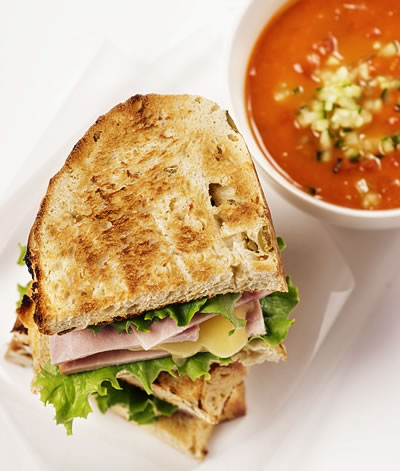I never put salt on anything. Why do I have high blood pressure?
It’s important to know that about 75% of the salt (sodium-chloride) Americans eat every day does not come from their salt shakers. It comes from processed and restaurant foods. These sources are absolutely loaded with salt, and many of us don’t even know it.

But it’s important to realize that about 75% of the salt (sodium-chloride) Americans eat every day does not come from their salt shakers. It comes from processed and restaurant foods. These sources are absolutely loaded with salt, and many of us don’t even know it.
They’re a crime not only for our health but our national health care budget when you consider how much damage, from strokes to heart attacks, that high blood pressure causes.
Below are the top six foods that contribute the most sodium to the U.S. diet. Some, like the #1 source (breads and rolls) don’t even taste salty. (That’s right, it’s not just the French fries we need to watch out for.)

The top six sodium sources in America are:
- Breads and rolls
- Cold cuts and cured meats
- Pizza
- Soup (especially many canned and restaurant soups)
- Sandwiches
- Poultry
So if you aren’t already doing so, get in the habit of reading food labels. The daily sodium limit for most people that has been recommended by the Pritikin Eating Plan since the 1970s is no more than 1,500 milligrams a day. It is now also the recommendation of the American Heart Association and other public health institutions.
FDA efforts
Hopefully, too, we’ll soon be seeing less salt in our prepared foods. Recently, the U.S. Food and Drug Administration has been urging the food industry and restaurants to voluntarily reduce salt levels in their products to help reduce Americans’ high salt intake.
In an FDA news release: “It’s no easy task for consumers to consume the recommended amount of sodium in their diets. We want to help reduce the amount of sodium across the entire food supply. There are few interventions that could potentially have as great an overall benefit to public health.”
Beyond Sodium
If you’re still asking “Why do I have high blood pressure?”, keep in mind that hypertension, or high blood pressure, is not just about eating too much sodium. There are several lifestyle-related factors, in addition to high salt intake, that contribute to the development of hypertension, including:
- Being overweight
- Excess alcohol intake
- Smoking
- Little or no daily exercise
Seven Tips For Reducing Blood Pressure
Below are seven key guidelines taught by the physicians, dietitians, and other faculty at the Pritikin Longevity Center for lowering blood pressure to normal levels. Pritikin is a wellness health resort in Miami that since 1975 has taught thousands to control blood pressure through healthy lifestyle changes.
They work extraordinarily well, research published in peer-reviewed medical journals has found. For example, in an analysis of 1,117 men and women with hypertension who came to the Pritikin Longevity Center for three weeks, both systolic and diastolic blood pressure fell to normal or near-normal levels. Of those taking pills for hypertension (598 patients), 55% left Pritikin pill-free, and the majority of the others had their dosages reduced.1
From the faculty at the Pritikin Longevity Center:
1. Eat at least 5 servings of vegetables and 4 servings of fruits daily.
A vegetable- and fruit-rich eating plan helps ensure that you’re eating plenty of foods full of stomach-filling volume, yet low in calories, enhancing your weight-loss efforts. Losing excess weight is one of the most effective ways to lower blood pressure. Eating a lot of fruits and vegetables also means you’re eating rich sources of potassium, magnesium, and calcium. Many studies have found that foods rich in these minerals help blunt some of the toxic effects of sodium.
2. Cut back on calorie-dense foods loaded with fat, sugar, and/or refined grains.
Doing so will also enhance your weight-loss efforts.
3. Limit consumption of sodium to a healthy level.
The physicians and other faculty at Pritikin agree with sodium recommendations established by the American Heart Association as well as the Centers For Disease Control2. AHA advises that adult Americans limit their consumption to less than 1,500 mg of sodium a day. CDC supports the same recommendation for the majority of Americans.
Limiting salt intake really works, especially for those most in need. Many studies have shown that the higher blood pressure is and the more salt is restricted, the greater the fall in blood pressure.
4. Limit alcohol drinking.
Excess alcohol drinking (more than 3 drinks daily) has been shown to increase the risk of hypertension.
5. Exercise daily.
Daily physical activity promotes loss of excess weight, vital for controlling blood pressure. It also stimulates the body’s production of beneficial chemicals like nitric oxide that expand blood vessels and increase blood flow.
6. Get adequate intake of calcium, omega-3 fatty acids, and vitamin D
Studies suggest that adequate amounts of all the above may help with blood pressure control.
- For calcium, the most effective and safest source is food, not supplements. The Pritikin Eating Plan is a rich source of calcium, adding up to about 800 to 1,000 mg daily. True, this amount is slightly less than the current RDA of 1,000 to 1,200 mg for older American adults, but our RDA is high because our typical American diet is high in calcium leachers like salt, meat, and refined carbs. With Pritikin foods, you’re losing less calcium, which means you likely need less.
- Omega-3 fatty acids: Like calcium, food sources of omega-3 fatty acids are preferable to supplements. While there is no RDA for omega-3s, a reasonable goal is an average of 1 to 2 grams daily, which is easily met with the Pritikin Eating Plan. Foods rich in omega-3s include cold-water fish such as salmon, mackerel, halibut, trout, herring and sardines, as well as walnuts, flaxseeds, beans (especially soybeans), and dark green leafy vegetables
- Vitamin D. Adequate blood levels of vitamin D are 25 to 50 ng/mL. It is a good idea to have your blood levels tested. To help raise levels, enjoy a little sunshine, if your dermatologist allows. Supplementation, under your physician’s care, may also be necessary.
7. Quit smoking, or don’t start.
Sources
- 1 Journal of Applied Physiology, 2005; 98: 3.
- 2 http://www.cdc.gov/VitalSigns/pdf/2012-02-vitalsigns.pdf